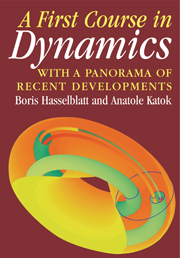Book contents
- Frontmatter
- Contents
- Preface
- 1 Introduction
- PART 1 A COURSE IN DYNAMICS: FROM SIMPLE TO COMPLICATED BEHAVIOR
- 2 Systems with Stable Asymptotic Behavior
- 3 Linear Maps and Linear Differential Equations
- 4 Recurrence and Equidistribution on the Circle
- 5 Recurrence and Equidistribution in Higher Dimension
- 6 Conservative Systems
- 7 Simple Systems with Complicated Orbit Structure
- 8 Entropy and Chaos
- PART 2 PANORAMA OF DYNAMICAL SYSTEMS
- Reading
- APPENDIX
- Hints and Answers
- Solutions
- Index
7 - Simple Systems with Complicated Orbit Structure
Published online by Cambridge University Press: 05 June 2012
- Frontmatter
- Contents
- Preface
- 1 Introduction
- PART 1 A COURSE IN DYNAMICS: FROM SIMPLE TO COMPLICATED BEHAVIOR
- 2 Systems with Stable Asymptotic Behavior
- 3 Linear Maps and Linear Differential Equations
- 4 Recurrence and Equidistribution on the Circle
- 5 Recurrence and Equidistribution in Higher Dimension
- 6 Conservative Systems
- 7 Simple Systems with Complicated Orbit Structure
- 8 Entropy and Chaos
- PART 2 PANORAMA OF DYNAMICAL SYSTEMS
- Reading
- APPENDIX
- Hints and Answers
- Solutions
- Index
Summary
This chapter presents a rich array of properties of a collection of examples. Its coherence derives from the fact that it is part of a general theory we outline in Chapter 10. The examples (other than the quadratic map f4) are instances of hyperbolic dynamical systems (or symbolic dynamical systems), and the properties we derive here are largely properties common to hyperbolic and symbolic dynamical systems.
GROWTH OF PERIODIC POINTS
Periodic orbits represent the most distinctive special class of orbits. So far we have mostly encountered maps with few periodic orbits or, as in the case of a rational rotation, only periodic orbits. In these basic examples different periods did not appear for the same map. Even the most complex situations so far still involve periodic orbits neatly organized by period in families such as invariant curves in plane rotations, linear twists, the time-1 map for the mathematical pendulum, or billiards. There we placed more emphasis on coherence than complexity. Now we encounter the first examples with a different periodic pattern. In these cases, when periodic points of different periods are present, we want to count them.
Definition 7.1.1 For a map f: X → X, let Pn(f) be the number of periodic points of f with (not necessarily minimal) period n, that is, the number of fixed points for fn.
- Type
- Chapter
- Information
- A First Course in Dynamicswith a Panorama of Recent Developments, pp. 196 - 241Publisher: Cambridge University PressPrint publication year: 2003



